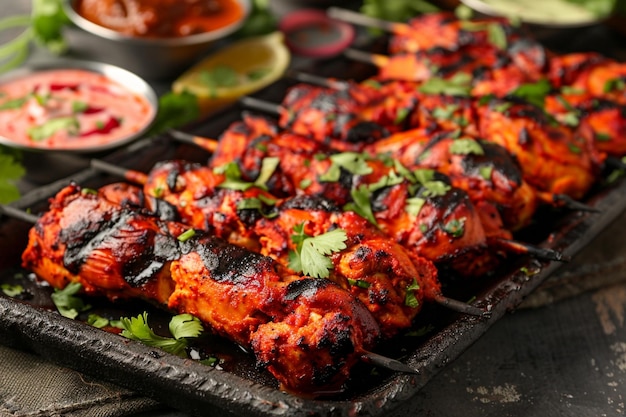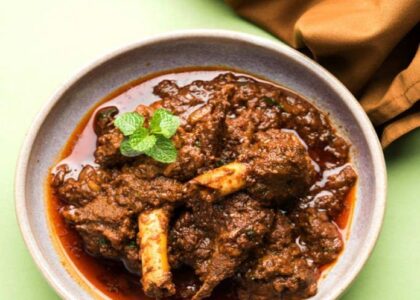One key fact is that North Indian cuisine is heavily influenced by the region’s climate and environment. The richness and creamy gravies of many dishes are often a clue to these characteristics, although this isn’t always the case. North India is home to a variety of smaller, distinct regional culinary traditions, including those from Kashmir, Himachal Pradesh, Uttaranchal, Uttar Pradesh, Punjab, and more. While Kashmiri, Punjabi, and Mughlai cuisines are the most well-known, the flavors from other regions are equally worth exploring.
Now, let’s dive into the must-try top ten dishes from these regions!
1. Dal Makhni:
Originally from Punjab, Dal Makhni has become one of the most beloved Indian lentil dishes, both within India and internationally. This flavorful dish combines red kidney beans (also known as urad) and whole black lentils, cooked in a rich, tomato-based sauce. It’s prepared slowly, with generous amounts of ghee, along with seasonings like ginger-garlic paste and chili, giving it its signature depth of flavor.
The term “Makhni,” which means butter, refers to the final touch of melted ghee or butter that gives the dish its iconic velvety texture. Often garnished with cream or yogurt, Dal Makhni is typically enjoyed with naan or roti and remains a popular choice during festive occasions and a staple in many restaurants across India.
2. Tandoori Chicken:
Tandoori Chicken, a dish named after the Persian word tannur meaning “fire,” is one of the most iconic and widely loved items in Indian cuisine. The dish features chicken marinated in yogurt and seasoned with a blend of tandoori masala, nutmeg, and cumin, then threaded onto skewers.
What sets Tandoori Chicken apart is its unique cooking method. Traditionally, it’s cooked in a cylindrical clay oven called a tandoor, where it is exposed to high temperatures, resulting in tender, flavorful meat with a distinct smoky taste. A popular theory suggests that the dish was created by Kundan Lal Gujral, who invented it at his Moti Mahal restaurant.
3. Shahi Paneer:
Shahi Paneer is a rich and flavorful cheese curry that originates from India’s Mughal cuisine. Made with paneer (Indian cottage cheese), onions, almond paste, and a creamy, spiced tomato sauce, it’s a dish that offers both indulgence and comfort.
Typically served with Indian breads like naan, roti, or puri, Shahi Paneer is often called the “Royal Paneer” due to its regal origins. It’s a popular choice for special occasions and festive meals, often enjoyed as a vegetarian main course. Garnished with fresh coriander leaves, Shahi Paneer is not only hearty and nutritious but also a truly luxurious treat.
4. Kadhi:
A wide range of Indian dishes uses yogurt or buttermilk as a base and are traditionally thickened with gram flour (besan), all falling under the umbrella term “Kadhi.” While Kadhi is widely enjoyed across India, each region has developed its own variations, which differ in ingredients, consistency, flavor, and preparation.
The Punjabi Kadhi, known for its thick texture and the addition of pakora fritters, is one of the most popular versions. Other well-known types include the Sindhi, Gujarati, Rajasthani, and tamarind-based Kadhi. A true comfort food, Kadhi is typically served with rice or roti, offering a soothing, satisfying meal.
5. Butter Chicken:
Butter Chicken, also known as Murgh Makhni, is undoubtedly one of the most iconic Indian dishes, commonly found at nearly every Indian restaurant worldwide. The dish was invented in the 1950s at Moti Mahal, a renowned restaurant in Delhi, by Kundan Lal Gujral. According to the story, the chefs at the restaurant, looking for a way to use leftover marinade, mixed it with tomatoes and butter, then simmered tandoor-cooked chicken in this flavorful concoction. Little did they know, they had unknowingly created a dish that would become a beloved classic and a global symbol of Indian cuisine.
6. Biryani:
Biryani is a time-honored and iconic dish with roots tracing back to the Mughal Empire. Known for its rich, aromatic flavors, it is a combination of carefully selected ingredients that come together to create a culinary masterpiece. The base of biryani consists of long-grain basmati rice, prized for its fragrance and texture. This rice is typically paired with a choice of meat, such as chicken, mutton, or beef, although vegetarian versions with vegetables or even eggs can also be made. The dish is then seasoned with an array of spices, such as cumin, cinnamon, cloves, and cardamom, which lend the biryani its signature depth of flavor.
In addition to the basic ingredients, biryani can be enriched with a variety of optional elements that elevate its taste and presentation. Dried fruits like raisins or apricots, crunchy nuts such as cashews or almonds, and the creamy tang of yogurt are often added to provide texture and a balance of sweet, savory, and sour notes. The result is a beautifully layered dish, where each grain of rice is infused with the spices and flavors from the meat or vegetables, creating a dish that is as visually stunning as it is delicious. The popularity of biryani has only grown over the centuries, with regional variations emerging across India and beyond, each adding its own unique twist to this beloved classic.
7. Palak Paneer:
Palak Paneer is a beloved vegetarian dish in Indian cuisine, known for its rich and flavorful combination of ingredients. It consists of paneer (Indian cottage cheese) cooked in a thick, vibrant sauce made from puréed spinach, seasoned with tomatoes, garam masala, garlic, and a blend of aromatic spices. The name of the dish reflects its core ingredients, with “Palak” meaning spinach in Hindi, and “Paneer” referring to the cheese.
Though Palak Paneer has its origins in the Punjabi region, variations of the dish can be found throughout India, each adding its own regional touch. This highly nutritious dish is often enjoyed with rice or traditional Indian flatbreads such as naan or roti. Versatile in its appeal, Palak Paneer can be enjoyed at any time of the day—whether for breakfast, lunch, or dinner—making it a comforting and wholesome meal for all occasions.
8. Rogan Josh:
Rogan Josh is a fragrant and flavorful lamb curry believed to have Persian origins, though it is now most closely associated with the Kashmir region of India. The dish is known for its tender lamb cooked in a rich, thick, and fiery red sauce, which derives its distinctive color and heat from Kashmiri chilies. The lamb is typically slow-cooked in a gravy made from browned onions, garlic, yogurt, ginger, and a blend of aromatic herbs and spices, resulting in a stew that is both rich and deeply flavorful.
The name “Rogan Josh” is derived from two key words: rogan, which refers to clarified butter or oil, and josh, which signifies passion or heat. These elements reflect the dish’s rich texture and intense, fiery flavors, making Rogan Josh a beloved and iconic curry that captures the essence of Kashmiri cuisine.
9. Dahi Bhalla:
Dahi Bhalla is one of the most cherished street snacks in India, particularly popular in the northern regions of the country. Known for its refreshing and flavorful profile, it is often enjoyed during festivals like Diwali and Navratri, adding a festive touch to the celebrations. The dish consists of soft, spongy bhallas (lentil fritters) that are soaked in yogurt and served with an array of tangy and sweet chutneys. These chutneys—typically made from tamarind and mint—add layers of complexity to the dish, balancing the mildness of the yogurt with their rich, vibrant flavors. Often sprinkled with chaat masala, a mixture of spices that includes cumin, coriander, and black salt, Dahi Bhalla offers a perfect blend of sweet, sour, spicy, and savory notes in every bite.
This chilled snack is a popular choice for both casual gatherings and festive meals. The bhallas are typically made by soaking urad dal (black gram) overnight, then grinding it into a batter that is deep-fried into round fritters. Once prepared, the bhallas are drenched in cool, creamy yogurt and topped with chutneys and spices, which makes it a perfect treat during hot weather or as a starter before a larger meal. Dahi Bhalla is not only a flavorful snack but also a dish that embodies the essence of Indian street food—vibrant, diverse, and bursting with flavor—making it a beloved choice among food enthusiasts across the country.
10. Peas and cheese curry:
Paneer, a type of farmer’s cheese or dry curd cheese, is a key ingredient in many Indian vegetarian dishes due to its mild, delicate flavor and firm texture. In one of the most popular vegetarian preparations, Mutter Paneer, the cheese is cooked with green peas (mutter) in a flavorful, tangy gravy. The gravy is typically made from a blend of tomatoes, onions, ginger, garlic, and an assortment of aromatic spices, creating a rich and creamy sauce that complements the soft paneer cubes and the sweetness of the peas. This dish is beloved for its balanced flavors, offering a satisfying combination of creamy, savory, and slightly tangy notes, making it a favorite in Indian cuisine.
Mutter Paneer is undoubtedly one of the most frequently ordered vegetarian dishes in Indian restaurants, both in India and internationally. Its popularity stems from its versatility and its ability to be enjoyed with a variety of Indian breads like naan, roti, or paratha, as well as with rice. The dish is a comforting, wholesome meal, ideal for both casual dining and special occasions. Its widespread appeal is a testament to the love for paneer-based dishes in Indian cuisine, as well as the dish’s perfect blend of texture, taste, and nutrition, which makes it a staple in vegetarian cooking across the country.
North Indian cuisine offers an incredible blend of flavors, from fiery curries and succulent Tandoori Chicken to slow-cooked Mutton Rogan Josh, and the ever-popular creamy Butter Chicken. Each region brings its own unique twist to the culinary scene, making North Indian food a delightful fusion of taste, tradition, and diversity. No matter where you go, there is always something new and exciting to savor!









